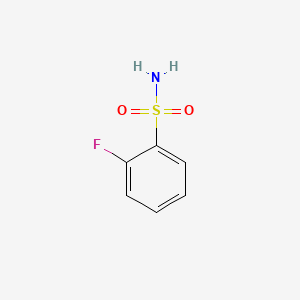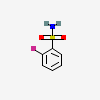2-Fluorobenzenesulfonamide
- 2-Fluorobenzenesulfonamide
- 30058-40-3
- 2-fluorobenzene-1-sulfonamide
- Benzenesulfonamide, 2-fluoro-
- 2-Fbsa
- Create:2005-03-27
- Modify:2025-01-25

- 2-FBSA
- 2-fluorobenzenesulfonamide
- Benzenesulfonamide, 2-fluoro-
- 2-Fluorobenzenesulfonamide
- 30058-40-3
- 2-fluorobenzene-1-sulfonamide
- Benzenesulfonamide, 2-fluoro-
- 2-Fbsa
- MFCD00042283
- 2-fluorobenzenesulphonamide
- DTXSID80184110
- 2weg
- FBV
- fluorobenzenesulfonamide
- 2-fluorophenylsulfonamide
- 2-sulfamoyl fluorobenzene
- 2-flourobenzene sulfonamide
- 2-fluoro-benzenesulfonamide
- SCHEMBL307454
- 2-Fluorobenzenesulfonamide, 97%
- DTXCID90106601
- BBL100410
- STL554204
- AKOS000138240
- CS-W007653
- DS-2321
- PS-8604
- SY033879
- DB-021117
- F0557
- EN300-26993
- AN-652/43422954
- J-017753
- Q27460223
- Z45415581


H301 (95.1%): Toxic if swallowed [Danger Acute toxicity, oral]
H311 (95.1%): Toxic in contact with skin [Danger Acute toxicity, dermal]
H315 (97.6%): Causes skin irritation [Warning Skin corrosion/irritation]
H319 (97.6%): Causes serious eye irritation [Warning Serious eye damage/eye irritation]
H331 (95.1%): Toxic if inhaled [Danger Acute toxicity, inhalation]
H335 (95.1%): May cause respiratory irritation [Warning Specific target organ toxicity, single exposure; Respiratory tract irritation]
P261, P262, P264, P264+P265, P270, P271, P280, P301+P316, P302+P352, P304+P340, P305+P351+P338, P316, P319, P321, P330, P332+P317, P337+P317, P361+P364, P362+P364, P403+P233, P405, and P501
(The corresponding statement to each P-code can be found at the GHS Classification page.)
Aggregated GHS information provided per 41 reports by companies from 4 notifications to the ECHA C&L Inventory. Each notification may be associated with multiple companies.
Information may vary between notifications depending on impurities, additives, and other factors. The percentage value in parenthesis indicates the notified classification ratio from companies that provide hazard codes. Only hazard codes with percentage values above 10% are shown.
Acute Tox. 3 (95.1%)
Acute Tox. 3 (95.1%)
Skin Irrit. 2 (97.6%)
Eye Irrit. 2A (97.6%)
Acute Tox. 3 (95.1%)
STOT SE 3 (95.1%)
Patents are available for this chemical structure:
https://patentscope.wipo.int/search/en/result.jsf?inchikey=WFLBWYLZCQOPCA-UHFFFAOYSA-N
- ChemIDplus2-Fluorobenzenesulfonamidehttps://pubchem.ncbi.nlm.nih.gov/substance/?source=chemidplus&sourceid=0030058403ChemIDplus Chemical Information Classificationhttps://pubchem.ncbi.nlm.nih.gov/source/ChemIDplus
- EPA DSSTox2-Fluorobenzenesulfonamidehttps://comptox.epa.gov/dashboard/DTXSID80184110CompTox Chemicals Dashboard Chemical Listshttps://comptox.epa.gov/dashboard/chemical-lists/
- European Chemicals Agency (ECHA)LICENSEUse of the information, documents and data from the ECHA website is subject to the terms and conditions of this Legal Notice, and subject to other binding limitations provided for under applicable law, the information, documents and data made available on the ECHA website may be reproduced, distributed and/or used, totally or in part, for non-commercial purposes provided that ECHA is acknowledged as the source: "Source: European Chemicals Agency, http://echa.europa.eu/". Such acknowledgement must be included in each copy of the material. ECHA permits and encourages organisations and individuals to create links to the ECHA website under the following cumulative conditions: Links can only be made to webpages that provide a link to the Legal Notice page.https://echa.europa.eu/web/guest/legal-notice2-Fluorobenzenesulfonamidehttps://echa.europa.eu/substance-information/-/substanceinfo/100.153.0222-Fluorobenzenesulfonamide (EC: 624-430-9)https://echa.europa.eu/information-on-chemicals/cl-inventory-database/-/discli/details/157621
- Japan Chemical Substance Dictionary (Nikkaji)
- NIST Mass Spectrometry Data CenterLICENSEData covered by the Standard Reference Data Act of 1968 as amended.https://www.nist.gov/srd/public-law2-Fluorobenzenesulfonamidehttp://www.nist.gov/srd/nist1a.cfm
- Protein Data Bank in Europe (PDBe)
- RCSB Protein Data Bank (RCSB PDB)LICENSEData files contained in the PDB archive (ftp://ftp.wwpdb.org) are free of all copyright restrictions and made fully and freely available for both non-commercial and commercial use. Users of the data should attribute the original authors of that structural data.https://www.rcsb.org/pages/policies
- Springer Nature
- Wikidata2-fluorobenzenesulfonamidehttps://www.wikidata.org/wiki/Q27460223
- PubChemPFAS and Fluorinated Compounds in PubChemhttps://gitlab.com/uniluxembourg/lcsb/eci/pubchem-docs/-/raw/main/pfas-tree/PFAS_Tree.pdf?inline=false
- Medical Subject Headings (MeSH)LICENSEWorks produced by the U.S. government are not subject to copyright protection in the United States. Any such works found on National Library of Medicine (NLM) Web sites may be freely used or reproduced without permission in the U.S.https://www.nlm.nih.gov/copyright.html2-fluorobenzenesulfonamidehttps://www.ncbi.nlm.nih.gov/mesh/67060416
- GHS Classification (UNECE)GHS Classification Treehttp://www.unece.org/trans/danger/publi/ghs/ghs_welcome_e.html
- MolGenieMolGenie Organic Chemistry Ontologyhttps://github.com/MolGenie/ontology/
- PATENTSCOPE (WIPO)SID 403493553https://pubchem.ncbi.nlm.nih.gov/substance/403493553

